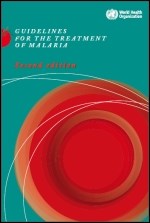Artemisinin-based combination therapy for treating uncomplicated Plasmodium vivax malaria
‘Killer’ fact
This Cochrane Review helped to define policies in the new 2010 edition of the World Health Organization(WHO)‘Guidelines for the Treatment of Malaria’.
Summary
The huge strides made since the widespread adoption of artemisinin-based combination therapies (ACTs) are reflected in the second edition of the WHO ‘Guidelines for the Treatment of Malaria’, with recommendations for using ‘on the spot tests’-and finessing the recommendations around various ACTs.
The first edition of the guidelines in 2006 led to countries abandoning some of the old treatments which were increasingly ineffective,and use combination therapy incorporating a highly effective new group of drugs, the artemisinin derivatives. These combinations have been shown toproduce consistently high curerates,and it is hoped that this approach will also reduce the risk of the malaria parasite developing further drug resistance and help reduce malaria transmission.
Members of the DFID funded Effective Health Care Research Consortium are part of WHO’s Malaria Treatment Guidelines Panel and contributed towards this new edition. The Consortium was commissioned to assess and synthesize relevant evidence,and to lead the Grading of Recommendations Assessment, Development and Evaluation(GRADE) process for formulating evidence based recommendations-a relatively new methodology to ensure a transparent link between evidence and guidelines. The Consortium carried out a large Cochrane Review that compared various ACT regimens,and convened the GRADE sub-group of the Panel. The GRADE sub-group prepared evidence summary profiles related to the key questions identified by the Panel. These summaries were endorsed by the panel and used to ensure an explicit link between the evidence and the new recommendations included in the Guidelines.
“There was so much new research since the last guidelines were published,we needed to commission this specialised team to synthesise them for the panel”, said Peter Olumese from WHO Roll Back Malaria, responsible for organizing the Guideline Panel.
Impact
The research has been used to inform the new edition of the WHO Guidelines for the Treatment of
Malaria. WHO guidelines are used by global,regional and national policy makers. Individuals living in malaria endemic areas are indirect beneficiaries of this research.
Researchers
David Sinclair. International Health Group, Liverpool School of Tropical Medicine, Liverpool, UK
Babalwa Zani South African Cochrane Centre, Medical Research Council, Cape Town, South Africa
Sarah Donegan International Health Group, Liverpool School of Tropical Medicine, Liverpool, UK
Piero Olliaro Research and Training in Tropical Diseases (TDR), WHO, Geneva, Switzerland
Paul Garner International Health Group, Liverpool School of Tropical Medicine, Liverpool, UK
Further Information
 WHO Guidelines for the treatment of malaria (2nd Edition) 2010
WHO Guidelines for the treatment of malaria (2nd Edition) 2010
To read the full Guidelines please follow this link:
 Cochrane Review: Artemisinin-based combination therapy for treating uncomplicated malaria To read the full review please follow this link: DOI: 10.1002/14651858
Cochrane Review: Artemisinin-based combination therapy for treating uncomplicated malaria To read the full review please follow this link: DOI: 10.1002/14651858
Read the article and watch video of Dr Peter Olumese from the World Health Organization's Global
Malaria Programme talking about the new edition of Malaria Treatment Guidelines:
Funding
This document is an output of the Effective Health Care Research Programme Consortium funded by the UK Department for International Development (DFID) for the benefit of developing countries. The views expressed are not necessarily those of DFID.
